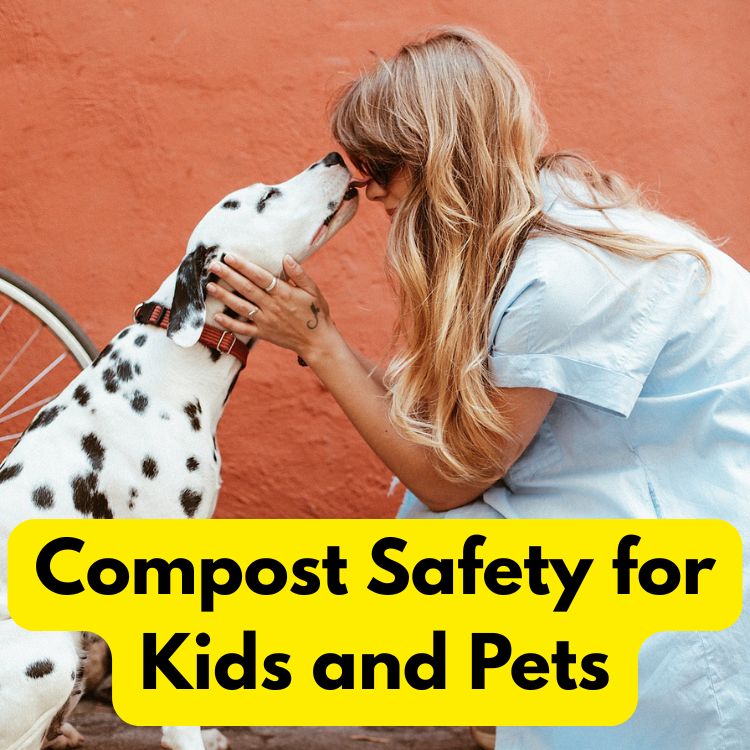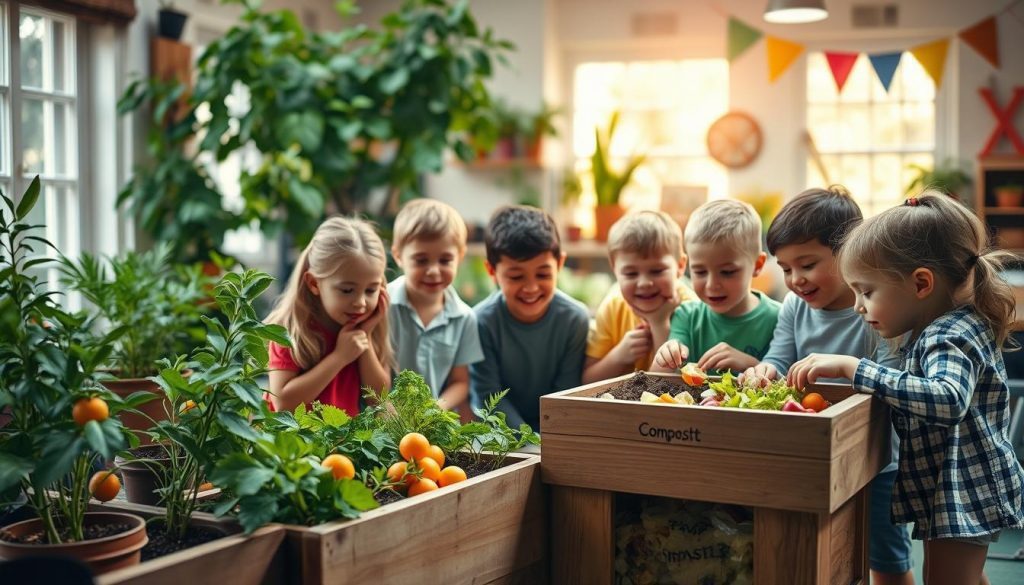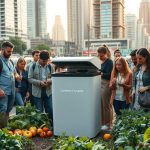Compost piles are playgrounds for curious kids and pets—bursting with wriggly worms, bold smells, and endless discoveries.
But when little hands and fuzzy noses come sniffing around, compost safety for kids and pets shoots to the top of my list.
There’s a knack to mixing the excitement of composting with smart habits that keep everyone happy and healthy.
Here, I’ll dish out friendly, practical tips for keeping tiny explorers and four-legged shadows safe around your compost bin.
You’ll learn the basics of safe compost handling, what to keep out of your heap, and fun ways to teach young ones about composting without worry.
Compost can be a safe, hands-on adventure for the whole family—and I’ll show you how to make that happen.
Curiosity in the Compost: Why Kids and Pets Love It
Compost piles are the ultimate backyard curiosity cabinet. At first glance, they look like simple heaps of kitchen scraps and garden trimmings.
But for kids and pets, compost is a portal to a world buzzing with hidden life, funky smells, and surprise treasures.
Curiosity draws little hands and paws almost as surely as a bell calls a dog to dinner!
If you want compost safety for kids and pets, understanding that magnetic pull is step one.
The Science-y Wonder of a Compost Pile
Compost isn’t just a mess of leftovers. It’s alive—swarming with tiny critters and crawling things. Kids notice the wild mix of plants, peels, eggshells, and mystery objects.
Pets, with their super-powered noses, pick up a carnival of scents that humans can’t imagine. When I show my kids or my dog the pile, their eyes go wide.
It’s like peeking under a rock to find a whole world wriggling away.
- Worms and bugs turn the compost into a bustling mini jungle. These little creatures break down scraps, teaching kids about nature and teamwork all at once.
- Decomposition in action looks like magic. One week there’s a banana peel, a few weeks later—dark, crumbly compost. The science is simple enough to explain: Living things (bacteria, fungi, insects) turn old food and leaves into rich soil.
- Heat and steam sometimes puff from the pile on a cool morning. That warmth is thrilling—proof that a hidden process is working hard. Even pets get excited by the sudden rush of heat.
A compost heap lets young minds and furry friends explore real, living science every day. The best part?
All this discovery happens right at home. For more on how to harness this educational power, see these tips on composting with kids from NatGeo Kids: How to compost with kids | Parents.
Sniff, Dig, Explore: What Draws Little Hands and Paws
Let’s face it: compost bins are nature’s original sensory toys. There’s so much to poke, prod, smell, and watch.
Here’s what makes these piles so irresistible:
- Smells – To us, compost might just smell “earthy.” But animals pick up layers we miss—apple cores, vegetables, and that musty compost perfume. It’s nose heaven for curious pups and cats.
- Textures – Slimy, crumbly, crunchy—compost is a jackpot of weird feelings. Kids want to squish, grab, and dig. Dogs and cats love to sniff, pat, and sometimes even roll (to our horror!).
- Discovery – Finding worms, pill bugs, and bits of forgotten food turns any compost poke into a mini scavenger hunt. My son once found a sprouting potato, and you’d think he’d struck gold.
- Warmth – Compost heaps generate heat, especially in cooler weather. This makes them a cozy resting spot for pets or even local wildlife, something discussed in this helpful article on attracting animals to compost piles: Keeping Wildlife Away From Your Compost.
Understanding these compost “superpowers” is key to teaching safe habits. It helps explain to kids—and reminds us—why boundaries are needed.
Setting compost rules doesn’t squash curiosity; it channels it.
If you’re looking for ways to make composting safe yet engaging, check out my step-by-step guide to hands-on composting education for kids here:
https://compostcharm.co.uk/how-to-teach-kids-about-composting/.
 Photo by Roxanne Minnish
Photo by Roxanne Minnish
By looking at compost through curious eyes, we can help kids and pets enjoy—and respect—this lively backyard ecosystem.
Compost Hazards: What to Watch Out For When Kids and Pets Are Near
Compost piles look harmless, but they’re like nature’s grab bags—full of surprises, both good and not-so-great.
Kids and pets treat them like open invitations for digging, smelling, and sometimes even tasting.
That curiosity is a joy, but the hazards in a compost bin are very real.
From bacteria that holiday in the muck to tempting table scraps that could make a pup sick, there’s more to think about than just dirty shoes and sticky fingers.
Here’s a look at what you—and your resident explorers—should watch out for.
Bacteria, Bugs, and Other Hidden Surprises
Life thrives in compost. That’s the magic!
But not every living thing is friendly. Alongside wiggly worms and heroic decomposing fungi, compost can harbor bacteria and bugs that kids and pets shouldn’t meet up close.
- Bacteria and Fungi: The warm, wet, organic setting is perfect for bacteria to multiply. A good compost pile should heat up enough to kill most harmful germs, but pockets of raw, undecomposed material might still carry E. coli, salmonella, or mold spores.
- If your child digs in and then rubs their eyes or tastes their fingers, sickness could follow. And dogs?
- Their strong noses don’t stop them from sniffing moldy, buggy scraps—mold can be dangerous to pets, sometimes leading to seizures or worse. According to Treehugger’s advice for compost safety, fungal spores and mold in compost present a higher risk for young children, pets, or anyone with a weaker immune system.
- Bugs That Bite Back: Roaches, ants, and even bees love a compost heap. Most are harmless if left alone, but a sting while digging for worms can turn garden glee into a full-blown meltdown.
- Pet Waste: Never ever add cat or dog poop to your home compost. These can carry parasites and diseases that stick around, risking everyone’s health.
- The NRDC’s guide to composting safety stresses that pet waste can contain harmful bacteria and parasites, and should be kept far away from any compost project involving kids or pets.
Toxic Table Scraps: What Not to Compost if Fido’s Around
You might think those leftover grapes, onions, or even coffee grounds are just scraps, but to your dog or cat, they’re forbidden snacks with disastrous consequences.
- The Usual Offenders:
- Grapes and raisins
- Onions and garlic
- Avocado
- Chocolate and caffeine
- Cooked bones
- Moldy bread and cheese
Anything from this list can cause serious harm—even a small nibble. Dogs, in particular, are notorious for rooting through piles for food and may come across these by accident.
To learn more about pet-unfriendly compost and mulch, check out this rundown on dangerous mulch, moldy compost, and other garden hazards.
If young helpers are tossing scraps in, it’s smart to talk about which leftovers are “pet poisons.”
Review my tips on how to turn composting into a hands-on, kid-friendly activity (minus the risky bits) over at how to teach kids about composting.
- Cat Curiosity: Cats sometimes lick at what smells intriguing, especially fermenting fruit or dairy. Both can trigger upset tummies or worse.
- Compost Pile Mold: Blue or white fuzz growing on scraps signals mold. This can be toxic for dogs, leading to drooling, tremors, or seizures.
Physical Risks: Sharp Objects, Tools, and Tumbles
Compost safety for kids and pets isn’t just about what’s inside the heap—it’s also about what’s hiding, sticking out, or rolling underfoot.
 Photo by Ilya Perelude
Photo by Ilya Perelude
Poking, prodding, digging, and climbing can lead to:
- Sharp Surprises: Twigs, broken shells, metal bits, and garden wire sometimes make their way into the pile. Small feet and hands—or paws—can be cut or punctured.
- Forgotten Tools: Rakes, forks, or hand trowels camouflaged by compost get stepped on by eager helpers. I’ve heard more than one garden story that ends with a stubbed toe or a mini meltdown over a surprise splinter.
- Slip and Slide: Decomposing matter is slippery, especially when moist. Kids scaling up a pile can easily lose their footing. Pets bounding onto the heap may land in a muddy mess or roll into the squishiest spot.
- Bin and Lid Hazards: Compost bins with heavy lids, sharp edges, or unstable sides can pinch fingers, tumble over, or create hiding spots no child or pet should explore alone.
Playful curiosity runs wild around compost, but so does risk. That’s why I always remind families—compost needs the same watchful eye as a swimming pool, especially if new scraps or tools are added.
Want more creative ways to keep little ones engaged and safe in the garden?
Find practical, interactive ideas for safe composting play at Composting for Kids.
By keeping those dangers in mind, you can make compost safety for kids and pets second nature—so the only surprises are happy ones, like the first worm or a whiff of new soil.
Fun and Safe: Making Composting Kid- and Pet-Friendly
Compost can be pure magic for kids and pets, but you want to keep the “adventure” on the safe and tidy side.
That’s where a few clever tweaks and family-friendly routines come in.
Safe composting doesn’t mean locking everyone out—it means building boundaries and habits that channel curiosity into bright, happy discoveries (not muddy disasters or vet visits).
Here’s how I mix compost safety for kids and pets with hands-on fun.
Build a Kid- and Pet-Proof Compost Bin
Keeping your compost pile off-limits to tiny humans and furry explorers starts with smart design.
You don’t need a fortress—just a bin with sturdy walls and a lid that even crafty paws and nimble fingers can’t crack.
 Photo by Sam Lion
Photo by Sam Lion
Here’s what works in my backyard:
- Go vertical: Choose a compost bin with high sides. Tumbling bins or solid-side wooden enclosures beat wire fences every time for keeping pets and little climbers out.
- Secure it up: Choose bins with locking or latched lids. If you repurpose an old container, add a child-safe lock.
- No sharp corners: Double-check for splinters, exposed nails, or ragged wire. Sand or tape rough bits so fingers and tails won’t get scratched.
- Stay grounded: Stake down your bin (or add weight to the bottom) to keep rowdy pets or determined kids from toppling the whole pile.
These simple steps let everyone look, learn, and even help “feed” the bin—without worrying about someone tumbling into the heap.
If you want even more compost bin inspiration, the Royal Horticultural Society covers great bin types for family gardens.
Start Safe Composting Habits Early
Making compost safety for kids and pets automatic just takes a little training (and consistency).
I get everyone into a few habits from day one—little rituals that feel fun but work like invisible fences.
Try these tricks:
- Hand-washing is key: Treat compost time like snack time—always wash hands after handling scraps or digging. I keep a bright bin of garden gloves by the back step to make this fun for kids.
- Scrap sort before you toss: If your kids love kitchen duty, teach them which leftovers are compost-safe and which are “no go” for pets. Let them act as the “scrap inspector” before anything gets dumped.
- Supervised visits: At first, make every compost trip a family outing. Talk about what’s inside, check for worms, and point out any “yucky” off-limits items. Kids and pets figure out the ground rules quicker this way.
- Tools for tiny hands: Give young helpers their own mini-trowels and shovels. Kids with proper tools dig for treasure instead of trouble.
- Set up a compost boundary: Mark a “do not cross” line around your bin using brightly colored stones or garden fence. Kids and pets quickly learn where the line is.
Building these routines isn’t just about making rules—it’s about turning safe composting into shared family time.
If you’re looking for easy, kid-approved projects, my guide to how to teach kids about composting offers even more ideas to build lifelong habits.
Composting as a Family Adventure: Making Safety Fun
Safety around the compost doesn’t have to mean “boring.” Turn regular reminders into playful games and challenges—your kids (and sometimes even the dog) will be first in line to help out.
Here are a few ways I’ve kept compost safety for kids and pets light, silly, and memorable:
- Compost critter hunts: Set up weekly scavenger hunts for harmless compost bugs—who can spot the most worms or pill bugs (without touching anything unsafe)?
- Name the rules, win a prize: Challenge the family to remember and recite safety rules (like glove-wearing or “no tasting” scraps) and reward extra effort with tiny garden prizes.
- Compost toss games: Turn adding food waste into a beanbag toss—just make sure all items are safe for the pile and the pets can’t sneak a snack.
- Pet-safe zones: Designate a spot near the compost where pets can dig, sniff, or play under supervision. Fill it with safe chew toys or digging sand to redirect their instincts.
- Sticker charts for hand-washing: Create a composting “superstar” chart. Every hand-wash after compost duty gets a sticker—fill the chart, win a new garden tool or a special treat.
Kids love challenges. Pets thrive on routine.
By mixing fun with safety, I keep composting as exciting as a treasure hunt—and as safe as a fenced backyard. Interested in more hands-on games and projects that keep curiosity and caution balanced?
My full step-by-step guide is packed with family-tested composting hacks: how to teach kids about composting.
Compost piles stay the center of all our eco-adventures, and no one—kid or pet—is left out of the fun (or the safety talk).
Building a Love for Composting That Lasts
Getting kids and pets excited about composting is like handing them a key to a secret club—one where every banana peel, eggshell, or fuzzy carrot becomes part of a bigger, greener story.
If you set the stage right, that curiosity and joy can turn into respect and lifelong habits. It starts with mixing safety, simple science, and a dash of playful routine.
Here’s how I’ve watched composting become a family (and furry friend) tradition, with both smiles and safety at the heart of it.
 Photo by KATRIN BOLOVTSOVA
Photo by KATRIN BOLOVTSOVA
Safety First, but Make It Playful
It’s easy to overthink compost safety for kids and pets—visions of mud splashes and sneaky paws running wild.
But the more natural the rules, the more memorable the experience. I use visuals, catchy reminders, and hands-on supervision. If hand-washing becomes part of the fun or “scrap sorting” turns into a game, kids remember.
Pets, too, quickly catch on when there are steady boundaries and lots of praise.
Try these tips for weaving safety into the compost routine:
- Let kids design their own “no-go zone” signs for the compost bin.
- Use silly songs about what goes in the bin and what stays out (bonus points for worm dance moves!).
- Practice safe handling with child-sized gloves and tools—kids love having gear just like grownups.
- Teach by doing: model good habits, like closing the compost lid every time or washing up together.
If you want more creative ways to spark compost enthusiasm and safe habits, check out how to teach kids about composting—this guide is packed with playful techniques that really stick.
Turning Simple Chores Into Mini Eco-Adventures
Compost chores don’t have to be boring lectures. I treat them like missions and mysteries. Kids become “compost detectives,” hunting for scraps that are safe to add, or “worm wranglers” tallying up tiny garden helpers.
Even the dog gets in on the act by sniffing (but not sampling) the compost, then earning a treat for waiting outside the bin zone.
Here’s how I make composting engaging for everyone:
- Give kids a personal project: let them run a mini worm compost jar or track which foods break down fastest.
- Create a sticker chart for safe compost behaviors—each glove worn, hand washed, or unsafe item spotted earns a star.
- For pets, set up supervised visits where they can sniff and observe but never eat or dig.
- Read compost storybooks or build compost-themed crafts on rainy days.
This approach transforms safety rules into something positive and rewarding, instead of just another set of “don’ts.”
Explaining the Benefits in Kid-Friendly Ways
If children and pets understand the “why” behind composting, they become champions for the cause.
When my kids learn that they’re feeding the soil, helping plants grow, and even saving the earth from too much waste, they light up. I use analogies like a “compost kitchen” where scraps cook up new dirt, or a “soil superhero squad” led by worms and bugs.
With pets, gentle boundaries and routine matter most—consistency keeps them safe and calm.
Some strategies I’ve found work like magic:
- Use clear, fun explanations: “We feed the compost just like we feed our pets or plants.”
- Share quick facts, like how composting lowers landfill waste or keeps the garden healthy.
- Celebrate milestones: the first batch of finished compost, finding new creatures, or completing a safety challenge.
- Let kids lead tours of the compost for visitors, showing what they know.
Studies point out that early green habits can have lifelong impact. Teaching compost safety for kids and pets today can seed eco-friendly lifestyles far into the future.
There’s even evidence that kids who compost grow up to be more conscious of waste and resource use—an all-around win for the planet. For inspiration and ways to keep your composting streak going strong, this piece on building compost bins that last a lifetime offers smart setup ideas.
Involve the Whole Family, Furry Members Included
What works best in my house? Making every family member, human and animal, part of the compost story.
Tiny hands “rescue” wiggly worms, big kids help measure scraps, and even the dog gets a role guarding the boundary.
We celebrate composting wins and laugh at the goof-ups (like the time I dropped the bucket and banana peels flew everywhere).
Here’s my checklist for building an all-in compost crew:
- Assign age-appropriate jobs to each child.
- Set a simple, safe routine for pets around the bin.
- Make composting part of regular outdoor play or garden tasks.
- Reward curiosity with extra garden time or something special when safety rules are followed.
If you’re excited to grow a deeper family connection to composting, you’ll find even more hands-on project ideas and tips for involving kids (and calming curious pets) at my in-depth how-to for family composting education.
With a blend of silly moments, strong boundaries, and teamwork, compost safety for kids and pets isn’t just possible—it’s the start of a love affair with eco-friendly living that can last a lifetime.
Conclusion
Compost safety for kids and pets is about turning every garden adventure into a safe, joyful memory—muddy boots, wagging tails, and all.
Keeping compost piles fun and worry-free just takes a bit of planning, a splash of humor, and clear house rules.
Protecting your curious little ones (and paws) means choosing the right scraps, sturdy bins, and making clean-up a happy ritual.
Adjust your composting routine as your home grows—a few simple habits now will make your green space safer and more welcoming for everyone who loves to explore.
If you’re looking for more ways to get the whole family into eco-friendly habits while keeping curiosity in check, take a peek at my favorite tried-and-true tips for family composting at how to teach kids about composting.
Your compost story is worth celebrating!
Share your own safety tricks or fun mishaps—let’s keep the garden giggles going and help others grow their own safe, thriving compost crew.
Thanks for stopping by, and happy (and safe) composting to every playful paw and pint-sized helper scratching for adventure in your backyard.






